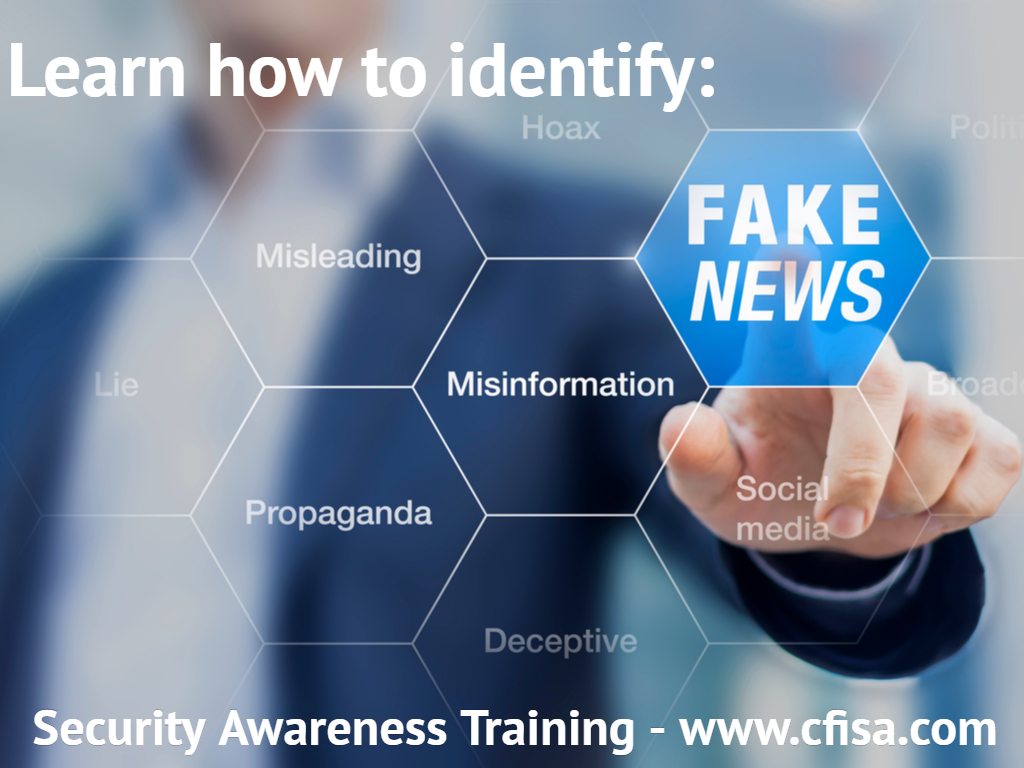
Fake News
Fake News and the Value of Security Awareness Training:
If you are on social media sites like Facebook you have most likely seen the unwittingly fake article post by your friends. These known scams include items like the following: Bill Gates is giving away $5,000.00 if you click on this link; free Southwest Airline ticket scam; Fake Ray-Ban glasses for cheap and the famous movie star just died article that ends up not being true.
Fact checking and the multiple verification of sources by the author are considered journalism best practices. As a consumer of news, we expect that the articles we read will provide the information in a format that is; objective, accurate, truthful, impartial and fair.
But unfortunately this is NOT always the case and we have to become smarter consumers of this information.
First off, let’s look at possible motivations of the fake news articles:
- Sell more newspapers or magazines
- Political propaganda to promote opposition agenda
- Advertising clicks or spam
- Fraud including phishing scams
- Spreading of malicious code and viruses
Look at the URL & Consider the Source:
Start out by looking at the URL where the article originated whenever possible and verify you are being routed to the correct legitimate site. Often the fake news sites have created URL’s that look partially correct. The list of fake news websites is growing and many are listed in Wikipedia and it is easy to research before you click on the article.
Realize that a news article passed to you on social media can easily be fake and that is frequently how the fake news stories go viral. Always consider the source and do research before you react on line and share with others. Consider that your friends with extreme political views might be passing on articles based on their own beliefs.
Slow Down and Research:
Before you get all upset or excited about a news article you see, slow down take a deep breath and realize it might be a fake article! Look beyond the headline at the author and date of the article. Look for the authors byline or information on the source of the article.
Official looking “blog articles” could appear to be a news article when it is really just the authors opinion. In that case you would search for other articles on the same topic to find information from a trusted source. Many bloggers could care less about the fact-checking process and are just voicing their opinion.
Check the date of the article. You frequently will see fake articles from months ago still being passed around as current news despite the fact they are known fake articles.
If you are not sure if the site is legitimate, check the “about us” section and you might discover the motivations or direction of the site publishing the information. Search for information on the website to make sure you are visiting the legitimate news site you are looking for.
Is this a Joke? Be aware that there are increasing number of “fake joke” articles that actually look very real. That outlandish article you are reacting to could easily be satire and a joke.
Realize that photos can be fake and claims of corroboration and verification can be a lie. Watch out for an article in all caps or bad grammar. Once again, research is the best way to insure that this information is legitimate.
Know the Risk:
Some of the rogue fake news websites are infected with spyware or viruses. By simply visiting the websites you will be subject to adware bugs that will cause pop ups and open your device up to malicious code. The same virus spreading techniques used on adult websites are now being utilized on some of the fake news sites.
Some of the fake news websites are trying to attract as many visitors as possible to drive up online ad revenues. These sites can also be used to lure readers into becoming victims of attacks like phishing and malware including ransomware. These risk also extend to businesses and organizations when employees are using company devices and networks.
Final Thoughts:
As we are exposed to more and more fake news articles we will become more savvy and realize this is an ongoing problem that is not going away. The safest approach in dealing with all news articles is to verify the story independently prior to clicking on the links. It just takes a few seconds to open up a browser window and conduct a search on the headline to verify.
Ongoing security awareness training is a great way to educate employees to the risk associated to this important issue.
The value of security awareness training:
This is where “security awareness training” comes into play. Many of the same principles and best practices that are taught are very relevant to help us in determining fake news articles that come to us in various ways on the Internet. Some of the same best practices used to determine a “phishing email” can be used to weed out a fake news article.
CFISA has been providing online and in-person security awareness training since 2007. The CFISA training stresses the importance of slowing down when handling email and conducting research before we randomly click on email links and attachments. We should utilize the same best practices when reviewing the validity of news articles we are seeing on the Internet.
Security awareness training options can be found at the Center for Information Security Awareness – CFISA
